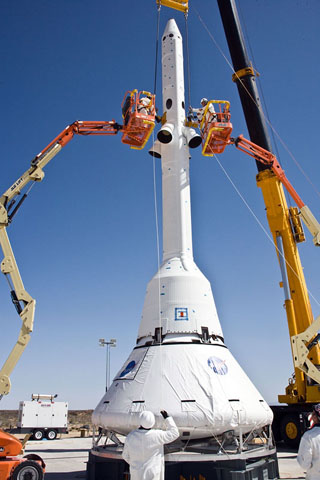How Can Astronauts Escape From an Exploding Rocket?

When NASA retires its space shuttles, the jobof taking astronauts back and forth between Earth and the International SpaceStation will fall solely on capsule-based spacecraft like the agency's newOrion spacecraft, currently pegged as an escape ship for the orbiting lab.
An important part of any spacecraft designed to carryhumansis the Launch Abort System ? a set of rockets and motors that are engineered todeliver the crew safely back to the ground should an emergency ? such as anexplosion or a fire ? occur during a launch.
NASA is planning to test Orion's Launch Abort System on Thursday, May 6,2010 at the U.S. Army's White Sands Missile Range near Las Cruces, N.M. This SPACE.com graphic shows how the escape system would work.
The Abort System motors will be containedwithin a tower-like structure at the topmost part of Orion. The crew capsulewill be attached to the base of the Abort System and, during a real launch, therest of the exploration vehicle and the rocket boosters would be below the crewcapsule.
During the test, the Abort System's threemotors will rip a mockup of an Orion crew capsule from its mooring atspeeds that should, ideally, be able to spare the crew capsule any damage duringa launch emergency.
The primary motor will fire with 500,000pounds of thrust to shoot the crew capsule away from the launch pad. Thealtitude control motor will steer and orient the capsule to maintain stability.Lastly, the jettison motor will pull the entire Abort System away from thecapsule, so a parachute can be released and the capsule can land.
If an explosion or fire were to occur duringa launch within or near the rocket boosters, which contain all the fuel neededto lift the vehicle into space, the crew capsule would have to be traveling athigh speeds in order to move a safe distance from the boosters. With this AbortSystem, the capsule may reach a speed of 445 mph (716 kph) during its firstthree seconds of flight.
Breaking space news, the latest updates on rocket launches, skywatching events and more!
The overall forces an astronaut would feelwhile lying on his back inside the escaping capsule would be slightly less thana jet fighter pilot would feel after hitting the eject button while flying in aseated, upright position, said Roger McNamara, launch abort systems directorfor the Orion program at Lockheed Martin, which is building the spacecraft forNASA.
"What we'll probably pull here is about15 1/2 Gs, but because the astronauts would be laying back in their launchposition they can take more than a jet fighter pilot can take," McNamarasaid.
Fighter pilots typically take around 9 Gs(nine times the force of gravity) during emergencyejections, but are sitting upright and feel the effects more, McNamara said.
Although these speeds and forces couldpossibly injure the astronauts, this system would be better than thealternative.
"They'll feel the effects. The bottomline is they'll be walking away," McNamara said.
To date, no Launch Abort System has been usedduring an American launch, though a similar system was used in 1983 to pull twoRussian cosmonauts to safety when a fire broke out at the launch pad during theattempt launch of their Soyuz T spacecraft. NASA's space shuttles are not equipped with launch abort systems, though astronauts do wear pressure suits and have trained on ways to bail out during extreme emergencies.
Launch abort towers are also used on China'sShenzhou manned spacecraft, as well.
- The Best Manned Spacecraft of All Time
- NASA's Most Memorable Missions
- Why Does Outer Space Look Black?
SPACE.com Managing Editor Tariq Malik contributedto this report. Visit SPACE.com at 8:30 am ET on May 6 for live coverage of the Orion Pad Abort 1 launch test.

Karen came to Space.com sister site LiveScience in 2010, after writing for Discover and Popular Mechanics magazines, and working as a correspondent for the Journal of the National Cancer Institute. She holds an M.S. degree in science and medical journalism from Boston University, as well as an M.S. in cellular biology from Northeastern Illinois University. Prior to becoming a journalist, Karen taught science at Adlai E. Stevenson High School, in Lincolnshire, Ill. for eight years.
